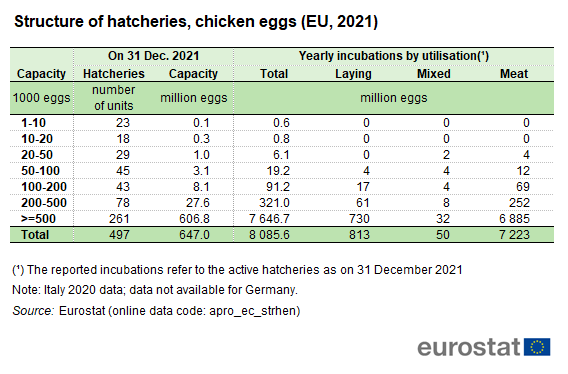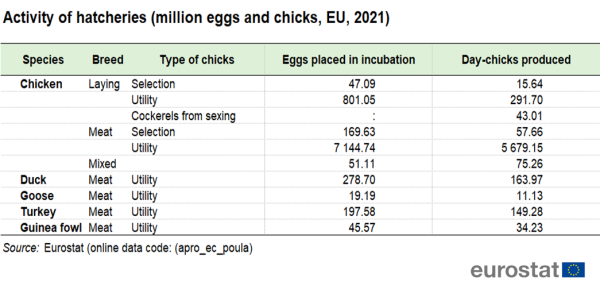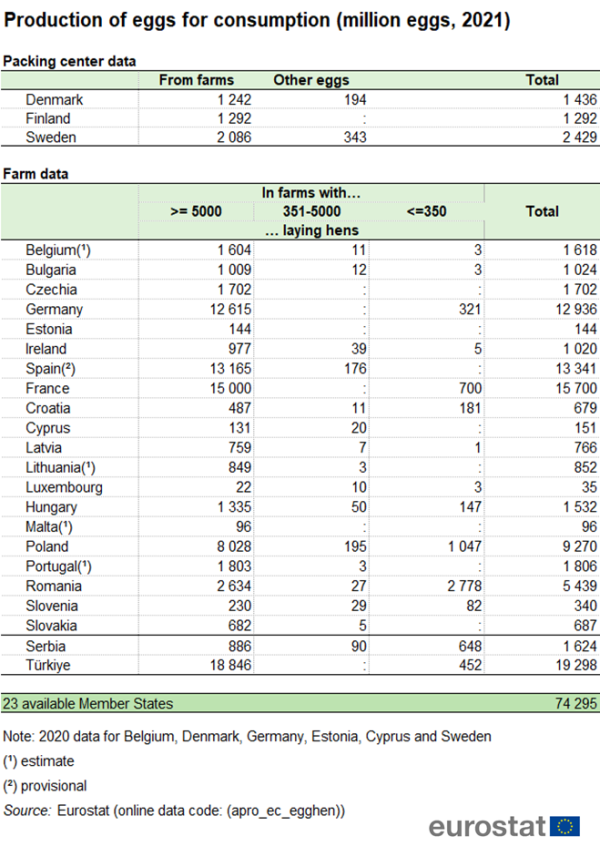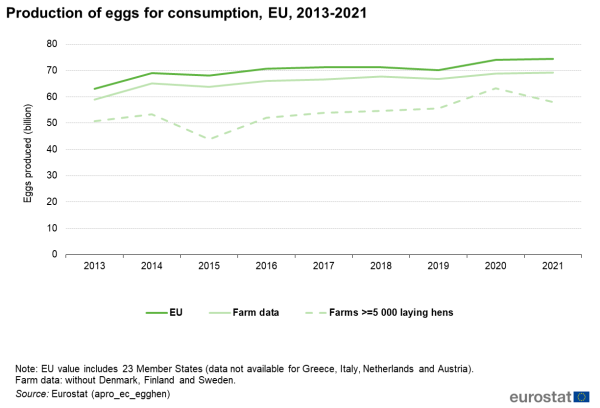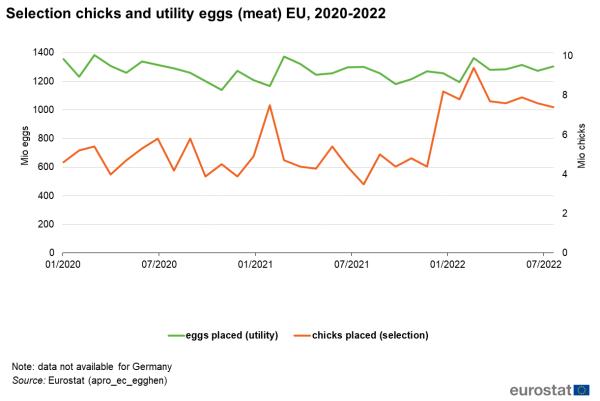Poultry statistics
Data extracted in December 2022
Planned article update: May 2025
Highlights
In 2021, the EU produced an estimated 96 billion eggs for consumption, of which the overwhelming majority came from farms with more than 5 000 laying hens.
Production of eggs for consumption, EU, 2013-2021
Poultry statistics collected by Eurostat cover the structure (annual) and the activity (monthly) of hatcheries, as well as the external trade of chicks, annual production (by the agricultural holdings) of eggs for consumption, and the poultry slaughtered in agreed slaughterhouses.
The production cycle of poultry is short and subject to volatility. This creates a challenge regarding the production of statistics, compounded by the need to report before the end of the production cycle, which is especially difficult in the case of poultry meat.
The poultry sector is organised, structured and designed to distinguish between breeding poultry and utility poultry that are raised for laying (eggs for consumption) or for fattening (meat). The sector is not all market-oriented, as some (semi-)subsistence farms can produce mainly for own-consumption.
The dominant poultry species in the EU is chicken (Gallus gallus domestica); hens provide the vast majority of the eggs consumed and chicken meat is the main poultrymeat. Nevertheless, meat from turkeys, ducks, geese and guineafowl are produced, but are of lower overall economic importance. Other poultry species such as ostriches and quails are not statistically significant.
This article provides a picture of the sector; background information is provided to help readers better understand the statistics available. The analysis describes the main trends.
Full article
Poultry production
Production by poultry farms
The agricultural census of 2020 reports that 1.63 billion poultry birds were reared across 2.67 million agricultural holdings in the EU. There are three kinds of poultry farming activity:
- The production of poultrymeat, by growing chicks and fattening poultry for slaughtering;
- The production of (non-fertilised) eggs for consumption, by keeping laying hens (or other fowls), collecting and selling eggs intended to be consumed or otherwise used, especially in the agri-food industry;
- The production of eggs for hatching. These fertilised eggs provide the stock of chicks that are used by each of the three kinds of poultry farming, selected for each according to their genetic performance.
Types of chicks
Utility poultry chicks are intended for their meat or for laying eggs for consumption. Selection chicks refer to the future parents and grandparents of other utility poultry chicks.
In 2021, the EU sector (excluding Germany – see methodological note) kept one selection chick for every 100 utility chicks in the meat sector and six female selection chicks for every 100 female utility chicks in the egg sector. Note that only female poultry are able to lay eggs. By contrast, some male chicks from some laying breeds are also suitable for fattening and are farmed as cockerels.
In 2021, 800 million eggs in the EU (excluding Germany) were placed in incubation to provide laying utility chicks, of which 262 million chicks (equivalent to 32.7%) were actually produced for this use along with a small number (43 000 chicks) that were kept as cockerels. A further 7.1 billion eggs were placed in incubation to become meat utility chicks, of which 5.6 billion became day-old chicks (79%).
Hatcheries
Among the types of enterprise involved in poultry production are the packing centres that mark, sort and pack eggs for consumption, the processors of the eggs unfit for packing, and the hatcheries.
Description
Hatcheries are establishments where eggs are incubated until they hatch and produce chicks. They are the starting point for poultry production. The type of chicks they produce (either for the production of meat, of eggs for consumption, or of breeding poultry) is the first information available as an indicator of future production.
The through-flow in hatcheries involves placing eggs in incubators, monitoring the incubation (in setters) up to the point of hatching (in hatchers) and delivering chicks. At any one moment, hatchers have a mixture of newly-born chicks and soon-to-be hatched eggs. These activities are largely automated, but important investment and management know-how is required to ensure that incubations do not fail.
The number of eggs in incubators is limited by the capacity of the hatcheries, but it is also driven by sales of chicks, which in turn reflects the needs of poultry farms.
Structure of hatcheries
The capacity of a hatchery is the number of eggs that can be incubated at the same time in setters; it thus excludes the eggs in hatchers. This capacity varies according to the egg species being incubated. Using the same equipment, a hatchery with a capacity for 10 000 chicken eggs would be able to hold less than 4 000 goose eggs, the latter requiring an incubation period of about 27 days in setters instead of 18 days for chicks. A hatchery of this size could produce 54 000 goslings annually compared to 203 000 chicks. Note that this example does not consider, among other things, losses of eggs nor the height of the incubation trays.
At Member State level, between 10 and 18 day-old chicks are produced for every spot or place in the setter over the course of a year.
More than half of all hatcheries in the EU have a capacity of more than 500 000 incubation places. These large hatcheries are responsible for almost 95% of the 8.1 billion chicken eggs that were incubated in the EU in 2021. About 90% of all eggs incubated were intended to be reared for the meat production sector (Table 1) in 2021. Note that not all the eggs placed in incubation resulted in day-old chicks (see below).
Activity of hatcheries
The activity of hatcheries can be summarised by looking at the incubated eggs and day-old chicks by species, breeding purpose and type of chicks (see Table 2). Data on these characteristics are provided by Member States on a monthly basis.
Two things of note: firstly, there are small discrepancies between the actual activity reported and the structural information referring to a whole year, and; secondly, some eggs initially intended for a given utility can provide chicks placed for mixed use, which explains the higher number of day-old chicks in this category than the number of eggs foreseen for this use.
Poultrymeat
Description
Data on numbers of poultry slaughtered are only a proxy for poultry production because it also includes quantities of imported live poultry that have been slaughtered and neglects poultry that have been exported live (especially cross-border). This difference can be corrected using foreign trade statistics on live poultry to calculate gross indigenous production (GIP). However, the improvement in accuracy at Member State level does not compensate for the limits in quality of statistics that are not designed for this purpose. For this reason, only data on slaughterings are used for comparison of national poultrymeat production.
Among Member States, the share of poultrymeat in all meat (carcass weight) in 2021 was over 50 % in Greece, Romania, Bulgaria, Slovenia, Hungary, Slovakia and Poland and, by comparison, was just over 80 % in Türkiye. The share was less than one quarter of all meat produced in Belgium, Spain, Germany, Austria, Ireland, Denmark and Luxembourg. The EU average rate was 30.2%.
Chicken accounts for the vast majority of poultrymeat produced in the EU (just over 80 % in 2021). Of the other poultrymeats, turkey (about 14 % in 2021) and duck (about 3 % in 2021) are the next largest, the remainder covering meats from guineafowl, geese and even ostriches among others.
Hatchery activity and slaughtering
Figure 1 displays the strengths and limitations of using hatchery statistics for the monitoring of anticipated poultrymeat production. The correlation between the series is strong (0.53 between eggs in setters and GIP for the period displayed). However, it also highlights limitations as the correlation should show a lag rather than be at the same time. In reality, the time lag between placing eggs in setters and the slaughter of the resulting broilers is short (around two months). In this way, eggs placed in setters can be viewed as a predictor of the GIP. In turn, the number of eggs in setters is also impacted by changes in the GIP. For example, when the number of eggs in setters decreases, it can be expected that the GIP decreases a few weeks later, but when meat production slows down, then fewer eggs in setters are perhaps needed as a response to short-term meat trends. The production system is so reactive that even ‘now-casting’ production is challenging.
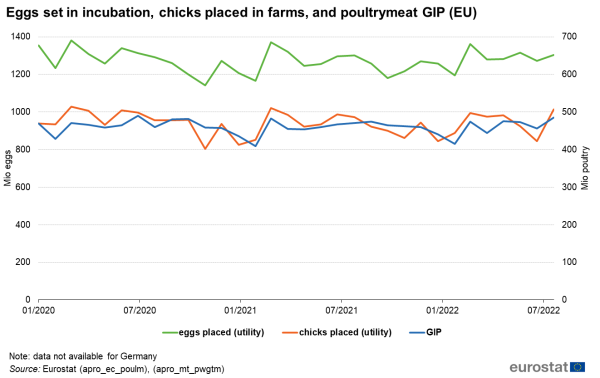
Source: Eurostat (apro_ec_poulm), (apro_mt_pwgtm)
Eggs for consumption
Production of eggs for consumption
On agricultural holdings that produce eggs for consumption, day-old chicks are grown to become laying hens that produce eggs for consumption. These eggs are collected and sold.
Table 3 displays summary information on these statistics.
On the basis of the data presented in Table 3 and on the number of laying hen places in the 27 Member States, the EU produced an estimated (see methodological notes) 96 billion eggs for consumption in 2021.
The data that are available show a clear upward trend in the production of eggs for consumption (Figure 2), punctuated by the impact of avian flu in 2015 and 2019. Production on farms with more than 5 000 laying hens account for the overwhelming majority (85 % to 92 %) of egg production, even though only one out of 400 agricultural holdings with laying hens meets this threshold. This underlines their market share at an EU level but, in some Member States, agricultural holdings with only a few laying hens make a significant contribution to egg production in the country.
Selection chicks
Selection chicks (kept for breeding future utility chicks) represent about 1% of day-old chicks. The numbers of selection chicks for breeding could be good predictors of the number of eggs from the next generation of utility chicks. However, the apparent lag is shorter than the time for growing selection chicks into pullets (see Figure 3). Nevertheless, and despite a weak correlation (r=31%), it can provide signals that indicate coming changes, albeit only one month in advance.
Source data for tables and graphs
Data sources
Coverage
Due to reasons of confidentiality, Germany is unable to share with Eurostat all the data required by the EU market Regulation. It is for this reason that EU data referenced in this article exclude Germany. This incomplete EU aggregate is not standard and the data cannot be published in Eurobase. However, the data for this modified aggregate are provided in the Excel annex.
Eggs for consumption
No EU-wide statistics are yet available on the production of eggs for consumption. Member States have agreed on the concept of egg production, measured by the number of eggs leaving a laying workshop over a defined period. In 2017, 15 Member States committed to providing these statistics either annually or, in the case of the Member States with the smallest sectors, three times per decade.
In the EU, egg marketing is subject to the prior check and sorting of the eggs in ‘packing centres’. However, some eggs bypass this step if they are delivered directly to processors. Additionally, farmers can sell eggs directly to consumers but in limited quantities. Member States can use data from packing centres or from farms. To fit with the farm gate concept, Denmark, Finland and Sweden measure egg production not only in terms of what is sorted in packing centres but also, where relevant, the eggs directly delivered to agri-food enterprises and to individual customers as well as eggs that are exported.
Of the remaining Member States, Belgium, Czechia, Germany, Estonia, Croatia, Luxembourg, Portugal and Finland provide these data on a voluntary basis. Only Greece, Italy, the Netherlands and Austria do not send statistics. From the reference year 2025 onwards, data collection will be obligatory under Regulation (EU) 2022/2379.
Hatchery activity and eggs for consumption
The number of layer chicks delivered by hatcheries is a good predictor of future egg production, once the set of technical parameters is known (average age at first laying, laying period duration, laying yield, losses, etc.). However, this cannot be illustrated, as Eurostat has no statistics on the monthly production of eggs for consumption. There is generally a two-month gap between the reporting of layer chicks hatching and them being settled as pullets into egg production at almost four months old. In theory, this two-month window is an opportunity to use the data on the hatching of layer chicks for predicting the production of eggs for consumption. However, this would need to be complemented with foreign trade statistics on live chicks, which are only available at a later date. The trade in chicks accounts for 17% of the number of placed layer chicks and, therefore, any timely forecast is also subject to uncertainty.
Eurostat estimates
Eurostat only provides aggregated values for hatchery statistics, as more detailed calculations would pose issue of confidentiality; at a national level, one in every eight values on activities of hatcheries is confidential, and one in every four on the structure of hatcheries.
The EU (excluding Germany) data on GIP and placing were compiled using foreign trade statistics (DS-645593) because they distinguish between the various Member States in the intra-EU exchanges.
The EU estimate of the production of eggs for consumption, extrapolated to cover those Member States without data, was based on the number of laying hen places provided in administrative notifications to the Directorate General on Agriculture and Rural Development (eggs common market organisation).
Context
Legal basis
- Hatchery statistics are collected by Eurostat under the market Regulation (EC) No 617/2008, on a monthly basis for the statistics on the activity of hatcheries and the foreign trade in chicks, and on an annual basis for the statistics on the structure of hatcheries.
- The 2017 ESS agreement on statistics on eggs for consumption was signed by 15 Member States and lays down the references for producing comparable statistics on eggs for consumption. These statistics are transmitted annually or, for those Member States with less than 3 million laying hens, three times per decade.
- Regulation (EC) No 1165/2008 covers the statistics on livestock and meat, including monthly poultry slaughtering.
- Regulation (EU) 2022/2379 on statistics on agricultural input and output will apply from 1 January 2025. An implementing Regulation on animal production statistics is expected to cover the statistical requirements of the three above texts.
Direct access to
See also
Main tables
Agriculture (t_agr), see:
Livestock and meat (t_apro_mt)
- Production of meat: poultry (tag00043)
Database
Agriculture (agr), see:
Poultry farming (apro_ec)
- Poultry - monthly data (apro_ec_poulm)
- Poultry - annual data (apro_ec_poula)
- Production of eggs for consumption and number of laying hens (apro_ec_egghen)
- Hatcheries - hens, annual data (apro_ec_strhen)
- Slaughtering in slaughterhouses - monthly data (apro_mt_pwgtm)
- Main livestock indicators by NUTS 2 regions (ef_lsk_main)
Dedicated section
Methodology
Legislation
